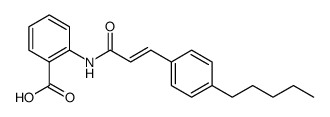N-(P-Amylcinnamoyl)Anthranilic Acid

N-(P-Amylcinnamoyl)Anthranilic Acid structure
|
Common Name | N-(P-Amylcinnamoyl)Anthranilic Acid | ||
|---|---|---|---|---|
| CAS Number | 99196-74-4 | Molecular Weight | 337.41200 | |
| Density | 1.178±0.06 g/cm3 (20 °C, 760 mmHg) | Boiling Point | 563.1±50.0 °C (760 mmHg) | |
| Molecular Formula | C21H23NO3 | Melting Point | N/A | |
| MSDS | Chinese USA | Flash Point | N/A | |
| Symbol |

GHS09 |
Signal Word | Warning | |
|
Des-Arg9-bradykinin causes kinin B1 receptor mediated endothelium-independent contractions in endotoxin-treated porcine coronary arteries.
Pharmacol. Res. 90 , 18-24, (2014) This study examined responses of isolated pig coronary arteries after kinin B1 receptor induction by endotoxin. Des-Arg9-bradykinin (DBK) induced concentration-dependent, endothelium-independent contractions in lipopolysaccharide (LPS)-treated but not untreat... |
|
|
Enhanced cytotoxicity in triple-negative and estrogen receptor‑positive breast adenocarcinoma cells due to inhibition of the transient receptor potential melastatin-2 channel.
Oncol. Rep. 34 , 1589-98, (2015) We previously demonstrated a unique protective role for the transient receptor potential, melastatin-2 (TRPM2) cation channel in breast cancer cells. In the present study, we investigated the chemotherapeutic effects elicited by inhibiting this protective rol... |
|
|
Diglycolic acid is the nephrotoxic metabolite in diethylene glycol poisoning inducing necrosis in human proximal tubule cells in vitro.
Toxicol. Sci. 124 , 35-44, (2011) Diethylene glycol (DEG), a solvent and chemical intermediate, can produce an acute toxic syndrome, the hallmark of which is acute renal failure due to cortical tubular degeneration and proximal tubular necrosis. DEG is metabolized to two primary metabolites, ... |
|
|
Expression and functional properties of TRPM2 channels in dopaminergic neurons of the substantia nigra of the rat.
J. Neurophysiol. 106 , 2865-75, (2011) Transient receptor potential melastatin 2 (TRPM2) channels are sensitive to oxidative stress, and their activation can lead to cell death. Although these channels have been extensively studied in expression systems, their role in the brain, particularly in th... |
|
|
Differential pathways for calcium influx activated by concanavalin A and CD3 stimulation in Jurkat T cells.
Pflugers Arch. 463 , 309-18, (2012) Sustained increase in [Ca(2+)](c) (Δ[Ca(2+)](c)) is a critical early signal from T-cell receptor (TCR/CD3). In general, Ca(2+)-release activated Ca(2+) channels (CRAC) are responsible for the Ca(2+) influx and Δ[Ca(2+)](c) after TCR/CD3 stimulation. However, ... |
|
|
TRPM2 cation channels modulate T cell effector functions and contribute to autoimmune CNS inflammation.
PLoS ONE 7 , e47617, (2012) TRPM2, a highly Ca(2+)-permeable member of the transient receptor potential melastatin-related (TRPM) family of cation channels, is expressed in cells of the immune system. We demonstrate firstly that TRPM2 cation channels on T cells critically influence T ce... |
|
|
Poly(ADP-ribose)glycohydrolase is an upstream regulator of Ca2+ fluxes in oxidative cell death.
Cell. Mol. Life Sci. 68 , 1455-66, (2011) Oxidative DNA damage to cells activates poly(ADP-ribose)polymerase-1 (PARP-1) and the poly(ADP-ribose) formed is rapidly degraded to ADP-ribose by poly(ADP-ribose)glycohydrolase (PARG). Here we show that PARP-1 and PARG control extracellular Ca(2+) fluxes thr... |
|
|
Transient receptor potential melastatin subfamily member 2 cation channel regulates detrimental immune cell invasion in ischemic stroke.
Stroke 45(11) , 3395-402, (2014) Brain injury during stroke results in oxidative stress and the release of factors that include extracellular Ca(2+), hydrogen peroxide, adenosine diphosphate ribose, and nicotinic acid adenine dinucleotide phosphate. These alterations of the extracellular mil... |